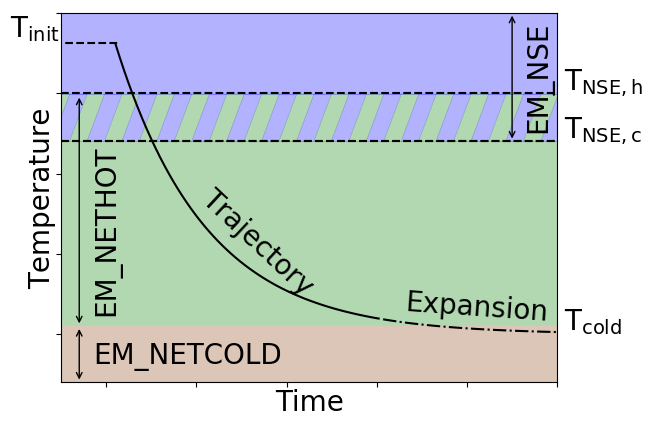 |
 |
Module to prepare the reaction network. More...
Functions/Subroutines | |
| subroutine, private | network_init () |
| Main initialising subroutine. calls reading subroutines and fills the reactionrate array. More... | |
| subroutine, public | prepare_simulation |
| All the necessary initializations and settings before the main loop. More... | |
| subroutine | create_rate_folder (path) |
| Create a folder with binary files that contain all necessary reaction data. More... | |
| subroutine, public | switch_evolution_mode (init) |
| Switches between NSE and network modes (EM_NSE / EM_NETHOT / EM_NETCOLD) More... | |
| subroutine, private | print_reactions () |
| Print an overview of the reactions involved in the calculation. More... | |
| subroutine, private | print_debug () |
| Print a debug file of the reaction. More... | |
| subroutine, private | getnames (ind, names) |
| Get the names of a certain reaction. More... | |
Module to prepare the reaction network.
This module contains subroutines that call other modules initialization. In addition it reads reaction rates and many other things.
| subroutine network_init_module::create_rate_folder | ( | character(len=*), intent(in) | path | ) |
Create a folder with binary files that contain all necessary reaction data.
This routine creates binary files in the exact format that WinNet needs to initialize the rate arrays. The reading of these files can be done much faster then reading the original files. The files are stored in the folder specified by the path argument. The folder is created if it does not exist. Using these files is specifically useful when running many trajectories.
Definition at line 454 of file network_init_module.f90.
|
private |
Get the names of a certain reaction.
| [in] | ind | Index of the reaction |
| [out] | names | Names of the participating isotopes |
Definition at line 955 of file network_init_module.f90.
|
private |
Main initialising subroutine. calls reading subroutines and fills the reactionrate array.
Reads included nuclei, Reaclib, theoretical weak rates, neutrino rates, tabulated rates, fission rates (and more) and prepares in this way the reaction rates global_class::rrate.
Edited:
Definition at line 53 of file network_init_module.f90.
| subroutine, public network_init_module::prepare_simulation |
All the necessary initializations and settings before the main loop.
To initialize it calls the init subroutines from other modules, e.g., readini::readini_init, analysis::analysis_init. It also prepares the first time depending on parameter_class::initemp and it fills the abundance array single_zone_vars::y and single_zone_vars::y_p.
Edited:
Definition at line 165 of file network_init_module.f90.
|
private |
Print a debug file of the reaction.
In contrast to print_reactions, this subroutine prints additional flags of a reaction. The structure of a file looks like:
| Reaclib chapter | isotope names | Q-Value | Source label |
| Amount destroyed/synthesized | double counting factor | ||
| "is_weak" | "is_resonant" | "is_reverse" |
An example of the file (debug_reac.dat) looks like:
...
5 n na32 p ne32 -16.606 rath
-1 -1 1 1 0 0 1.000
F F T
5 p na32 n mg32 18.317 rath
-1 -1 1 1 0 0 1.000
F F F
...
Definition at line 925 of file network_init_module.f90.
|
private |
Print an overview of the reactions involved in the calculation.
An example file (debug_all-reactions.txt ) looks like:
... O N E P A R T I C L E R E A C T I O N S 1 n ---> p Q= 0.782 MEV ffn Reaction type: weak 2 n ---> p Q= 0.000 MEV nen Reaction type: neutrino 3 p ---> n Q= -0.782 MEV ffn Reaction type: weak ...
Furthermore, a file ( debug_weak-reactions.txt ) containing all weak reactions is created that looks like:
OVERVIEW OF ALL WEAK-REACTIONS IN THE NETWORK 1 n ---> p Q= 0.782 MEV ffn 2 n ---> p Q= 0.000 MEV nen 3 p ---> n Q= -0.782 MEV ffn 4 p ---> n Q= 0.000 MEV nebp
Edited:
Definition at line 658 of file network_init_module.f90.
| subroutine, public network_init_module::switch_evolution_mode | ( | logical, intent(inout) | init | ) |
Switches between NSE and network modes (EM_NSE / EM_NETHOT / EM_NETCOLD)
The following conditions are included to switch the evolution mode:
| Evolution mode | Condition |
|---|---|
| EM_NSE | \(T_9\) > parameter_class::nsetemp_hot |
| EM_NETHOT | parameter_class::temp_reload_exp_weak_rates < \(T_9\) < parameter_class::nsetemp_cold |
| EM_NETCOLD | \(T_9\) < parameter_class::temp_reload_exp_weak_rates |
| EM_TERMINATE | Depends on termination criterion, see parameter_class::termination_criterion |
The following figure illustrates the different regions for an example trajectory:

Edited:
| [in,out] | init | Flag that indicates a necessary initialization |
Definition at line 530 of file network_init_module.f90.